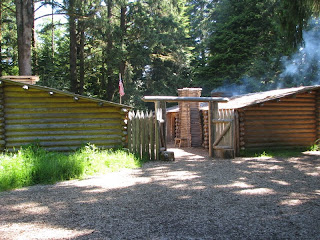May 11 - 12, Natchez Trace Parkway, Mississippi
We left ODK Farms on Saturday morning and drove to Vidalia, LA where we are staying at the Riverview RV Park. We stayed at this nice park when we visited the area in 2014. We are going to tour the Natchez Trace Parkway which starts in Natchez, MS and ends near Nashville, TN.
This is a very nice park beside the Mississippi River, and we can watch the river traffic from our site, like this very large barge. The tug was pushing at least 18 barges – it was so long we couldn’t get it all in one picture.
After dinner we took a walk on the Vidalia River Walk. This nice wide cement path starts at our RV park and follows the river. The area around the path is a park with grass, park benches and even a park bench swing. We walked about a mile and a half to the Vidalia Convention Center.
Sunday, Mother’s Day, we went to the Natchez National Historical Park and toured Melrose. In 1841, John McMurran had amassed a fortune from his cotton plantations and purchased 132 acres of land outside of Natchez on which to construct a country estate. The estate was finished in 1849. At that time Melrose was considered to be the finest home in all of the Natchez region. The house was locked so we could not see the inside, which must have been spectacular.
On the grounds behind the main house were a kitchen, carriage house, and the slave quarters. All these structures were built from wood - quite a contrast to the main house.
The garden area was
lush and beautiful. This large Magnolia tree
was blooming.
When we were here in 2014, we toured most of the mansions and plantations in the area, so we next headed to the Natchez Trace Parkway. The Parkway is 444 miles long and goes through 3 states – Mississippi, Alabama and Tennessee. Established as a unit of the National Park System in 1938 and officially completed in 2005, the Parkway commemorates the most significant highway of the Old Southwest. Our plan is to travel the entire 444 miles over the next 2 weeks.
After the American Revolution, frontiersmen from the Ohio Valley carried their products down the Mississippi River to Spanish controlled New Orleans and Natchez. After selling their goods and boats, they returned home on foot following a series of Indian trails from Natchez to Nashville – trails which evolved into the Natchez Trace. We get to follow in their footsteps in our nice air-condition Jeep on a nice, paved road!
We next stopped at Emerald Mound, built between 1200 and 1650 and is now a National Historic Site. Mississippians, ancestors of the Natchez Indians, transformed a natural hill into a sacred mound over perhaps 300 years. Covering eight acres, it is the second largest mound structure in the United States. The large rectangular mound once held eight smaller mounds, three along each side of a long plaza plus one at each end. Emerald Mound was an important ceremonial center for trade, ritual sporting contests, and social, political, and spiritual events.
We drove a short distance off the parkway to visit Windsor Ruins. Smith Coffee Daniel II, a successful cotton planter, completed construction of Windsor in 1861. Daniell owned 21,000 acres of plantation land in Louisiana and Mississippi. Unfortunately, he died in April 1861, only weeks after completing his mansion. His wife and children continued to live here but lost much of the family’s holdings during the civil war. The mansion had 23 rooms with an above ground basement, two residential floors, and an attic. The mansion survived the Civil War only to be destroyed by an accidental fire in 1890. Descendants of the Daniell family donated Windsor Ruins to the State of Mississippi in 1974.
We got back on the Parkway and stopped at the Sunken Trace, a short trail through a deeply eroded section of the original Trace. It rained off and on all afternoon, but we donned our rain jackets and hiked this trail. It is amazing that the trail was eroded down this deep by the thousands of travelers passing through.
Our last stop was at Grindstone Ford which marked the beginning of the wilderness of the Choctaw nation and the end of the old Natchez District. We hiked a short trail to the ford. On the way we passed a small cemetery. All the headstones we could read dated back to the 1800s. These two were dated 1852 and 1864.
We wanted to see Mount Locust, but it was closed due to storm damage from last summer. Before 1820, as many as 50 stands were established to host weary travelers and Mount Locust is the only one remaining. We are disappointed that we could not see it. We enjoyed seeing the first 50 miles of the Natchez Trace Parkway and look forward to seeing more.
Late Sunday night and early Monday morning we had a
huge storm with lots of thunder and lightning and pouring rain. This area is under flood warnings until
Thursday, so we’ll have to watch the weather closely.
.JPG)
.JPG)
.JPG)
.jpg)
.JPG)
.JPG)
.JPG)
.JPG)
.JPG)
.JPG)
.JPG)
.jpg)
.JPG)


.JPG)
Comments
Post a Comment